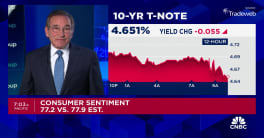Existing home sales for April, which will be released Friday by the National Association of Realtors (NAR), are expected to decline further to a pace of 4.85 million units following March's sales figure of 4.93 million. This would mark the second month that home sales have remained under the 5 million mark.
Due to tightening credit markets and an underperforming economy, pending home sales fell 1.0% in March and are down 21.7% overall from last year. According to Bear Stearns, "tighter mortgage lending standards, a massive supply of homes on the market, and fears of continued declines in home prices are likely to maintain downward pressure on home sales in the months ahead."
Mortgage applications have dropped for a third consecutive month, falling 2% in April. According to the latest senior loan opinion survey, 60% of banking officers surveyed said they have tightened lending standards.
"Our members are telling us that more buyers are looking at homes but are slow in signing contracts, and that's contributing to the weakness in pending home sales," said NAR President Richard F. Gaylord.
The supply of existing homes increased by three months to an overhang of 9.9 months, after falling to 9.6 months in February from January's 10.2 month supply. The supply for single-family homes is 9.5 months.
Economists from Desjardins expect the decline to continue in April. "Tightening credit conditions, lower demand for home mortgages, and fewer pending sales in March all indicate a new low for the home resale market. Only a significant drop in home prices could help stabilize the level of sales in the short term. We anticipate a monthly drop of a little more than 2.5%, taking sales to 4,800,000 units."
The national median existing home price was 200,700 in March, down 7.7% from a year ago. The slowdown in sales in high-priced areas has caused a downward pull to the national median with higher sales being seen in low-cost markets.
According to economists at BBVA, lower housing prices will do little to stimulate sales. "Under normal conditions, sustained improvements in affordability should lead to an increase in home sales. However, in the current crisis, the positive effects of higher affordability have been offset by tighter credit conditions."
Economists at BTMU said that low prices and lower interest rates were good reasons to buy, but high inflation and a weaker labour market have cause real incomes to fall over that time as well.
The Office of Federal Housing Enterprise Oversight (OFHEO) released Q1 housing price index on Thursday, which showed home sales were 1.7% lower than previous Q4 2007 results.
By Steve Stecyk and edited by Nancy Girgis







